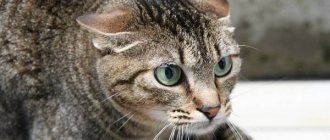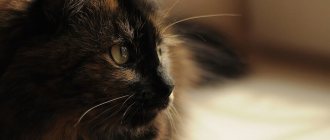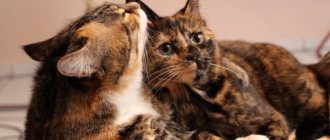The sudden loss of a beloved pet is a very sad event that many owners face. This is unfair and a terrible shock. There are many stories of cats dying for seemingly no reason. Other owners report cats dying from the disease within hours. Understanding the causes of sudden death in cats will help prevent the death of the animal.
Cats hide or hide their symptoms when they feel unwell. What may appear to be sudden death is the result of an illness in its final stages. These include sepsis, a bacterial infection of the blood, or shock caused by trauma. Other causes of sudden death in cats may be hereditary, such as hypertrophic cardiomyopathy.
Minimizing your cat's exposure to potential causes of sudden death in cats begins with regular veterinary check-ups and vaccinations against disease. You can also keep your cat exclusively indoors or create a closed outdoor enclosure to protect it from outside dangers.
Causes of death of cats
The lifespan of pets is much shorter than humans. There are not many causes of death for cats:
- natural – death from old age;
- from illness;
- sudden death as a result of an accident.
You can prepare for the first two reasons and alleviate the suffering of your pet. The sudden death of a cat occurs suddenly; it is impossible to know about it in advance. It is experienced much more acutely than the death of an animal due to natural causes.
From old age
On average, domestic cats live 12–15 years. Cats die of old age at 10–11 years of age, but they can live much longer and die at the age of 20. It all depends on the breed and individual characteristics of the animal.
Interesting! Outbred cats live especially long, since their genetic apparatus has not been damaged by inbreeding.
If the cat's age has passed the 13-year mark and he becomes less active and sleeps a lot, we can conclude that his life's journey is coming to an end. By human standards, this is almost 70 years of age.
Each subsequent year of life is plus 7 years. An animal dying of old age does not experience pain: it gradually loses its vitality and fades away.
If a cat dies at home, a caring owner should provide her with peace and good care.
From illness
Diseases that threaten the life of a cat:
- Infections. They take first place among the reasons from which an unvaccinated kitten can die. Free-ranging cats are also at risk. An animal can also become infected during a planned mating if the partner is sick. The owners may not be aware of this circumstance if the disease occurs in a latent (hidden) form.
- Kidney failure is a consequence of castration and sterilization and significantly shortens the life of cats. The disease is treatable if noticed in time. In its advanced form, it will lead to the death of the cat.
- Oncology. Unfortunately, animals also often die from cancer. The risk of this disease is especially high in adult cats, but cancer is increasingly being diagnosed in young cats.
Diagnostic methods in the clinic
What will need to be done to diagnose the cat's condition at the veterinary clinic will depend on the severity and nature of the injuries.
The veterinarian will examine the animal, measure basic vital signs, assess the patient’s general condition, and whether the pet’s life is currently in danger. In any case, even in the absence of visible injuries, an X-ray examination will be necessary: it will help assess the condition of the bones and respiratory system (presence of pneumothorax, pulmonary edema, etc.).
Ultrasound examination (ultrasound) is also performed to assess the condition of internal organs. Further diagnosis will depend on the presence, nature and severity of specific injuries.
Signs that a cat is dying
You can understand that a cat is dying by certain signs long before this sad event. Changes in behavior and appearance will tell the owners of a dying cat that its departure is inevitable.
Lack of appetite
One of the signs of illness or imminent death is loss of appetite. The cat first loses interest in food, eats without pleasure, and then stops eating altogether. Refusal of water for several days is a signal that the cat is dying.
The following symptoms should also raise alarm:
- an empty litter tray is evidence of a failure of the gastrointestinal tract;
- black bowel movements and vomiting indicate internal bleeding;
- dark urine - the kidneys cannot cope with filtration.
The consequences of an eating disorder will not keep you waiting - restoration of the body will be impossible.
Labored breathing
The accumulation of fluid in the lungs is a consequence of metabolic disorders and kidney failure. Breathing becomes frequent and shallow. Even with minor physical exertion, the cat develops shortness of breath.
Slow heart rate
Due to a malfunction of the excretory system and dehydration, the blood thickens. The heart has difficulty pumping it through the vessels that have lost their tone and begins to malfunction. The pressure drops and the heart rate decreases.
The normal heart rate of a healthy cat is 120–140 beats per minute. In a dying animal it will be uneven and weak. To determine the heart rate, you need to place your palm under the cat's left paw.
Specific smell
The cat's body weakens before death, waste and toxins are not eliminated through the intestines and urinary system. Metabolic products are released along with sweat, exhaled air, through the mucous membranes. An unpleasant odor begins to emanate from the cat. The appearance of this sign indicates that the pet will die soon.
Reduced temperature
Body temperature drops due to the decline of vital functions. Normally, the thermometer readings should not be lower than 37.7°C. If this value gradually becomes lower, the cat dies.
Important! This sign of imminent death can be determined without a thermometer. You need to touch the paw pads of the animal: they are cold on a dying cat.
Causes of mortality in growing kittens
After leaving the breastfeeding period, the animal's immune system is subjected to serious tests. Until this moment, the baby is protected by mother's milk, and inside the womb - the fetal membrane.
A sick cat can cause infection in babies when it bites the umbilical cord. If the female has mastitis, staphylococci and streptococci will pass to the cubs through the milk. Chlamydia causes pneumonia and purulent conjunctivitis. If examination of the female shows the presence of infectious diseases, the children must be transferred to artificial nutrition.
Viral infections
Intrauterine pathogens include herpes viruses, calcivirosis and panleukopenia. These diseases and illnesses cause death on the second or third day after birth.
The next dangerous period begins after the eighth week of life, so cats must be vaccinated against viruses at the age of two months.
Parasites
Can you die from worms, depriving? Round nematodes can enter a cat's intestines both before and after birth. A large number of worms leads to a reduction in nutrients entering the body, as well as poisoning by parasite waste. The worst case of injury is intestinal rupture.
Fleas themselves are not fatal. However, these insects are carriers of many infectious diseases and cause allergies. Flea bites cause itching and inflammation on the skin. Pathogenic bacteria multiply in scratches left after scratching. The presence of fleas in a pet reduces the body's resistance to dangerous diseases.
Foreign objects
Growing pets tend to try everything interesting. Often this interest causes objects to enter the digestive or respiratory system. Cats with long hair, when licking themselves, swallow a large number of individual hairs. Hair that gets into the stomach forms hard clumps that can block the intestines and cause peritonitis. In such a situation, an emergency call to the doctor is necessary.
Stages of death
Death is not an instant, but a process that gradually turns off the body, passing it through the following stages:
- Preagonia - loss of consciousness, cessation of blood circulation, pallor and cyanosis of the skin. This stage can last from several minutes to an hour.
- Terminal pause (preagonia). Breathing practically stops, pressure drops to zero. The oculomotor reflex disappears.
- Agony. Characterized by a lack of consciousness and tactile sensitivity. Breathing may resume and blood pressure may rise. Convulsions may occur.
- Clinical death. Complete stop of all vital processes. When carrying out resuscitation measures, it is possible to “start up” the cat’s body. The duration of the period is about 8 minutes.
- Biological death. This stage is irreversible and is characterized by the complete cessation of all physiological processes in the cat.
Behavior of cats before death
Before death, cats behave strangely, and it is impossible not to notice.
Cats leave home to die elsewhere. If the pet is free-range, then it has this opportunity. Many owners say that before leaving, an elderly or sick cat would cuddle and purr in a special way.
It is not difficult to track signs of imminent death if a cat dies of old age or a long-term illness and is in an apartment with its owners:
- Eating disorder. The cat seems to forget why it comes to the feeding place. She can sit near a bowl of food or water for a long time and never touch it.
- Loss of control over physiological functions. An older cat suddenly begins to empty his bowels and bladder outside the litter box.
- The cat constantly changes its resting place: it can lie down in a passable place or hide in dark, cramped corners.
- Disorder of the cat's motor functions: unsteadiness of gait, aimless walking around the house, loss of coordination.
- Constant meowing. This is how the cat tries to attract the owner’s attention and asks him to help.
- The pet stops performing “cat litter” - licking itself.
- The cat sleeps a lot.
Sunken eyes, dull fur, sudden weight loss, lethargy and apathy should alert the owner. A veterinarian's examination and palliative treatment will help prolong the cat's life if it is seriously ill.
Consequences of a cat falling from a height
Shock
Traumatic shock is a complex reaction of the body to damage, accompanied by depression of the nervous system and all vital functions. It is observed in most patients after a fall from a height and is a life-threatening condition.
Shock develops in response to damage to soft tissues and blood loss: the flow of pain impulses entering the cerebral cortex causes its depletion and inhibition that is prohibitive in its strength.
In a state of shock, the cat first becomes extremely excited, then, on the contrary, depressed, not responding to external stimuli, its muscles are relaxed, it cannot fully move, the temperature is low, the pulse is weak, the mucous membranes are pale.
Treatment will be aimed primarily at stopping the flow of pain impulses into the central nervous system and protecting it from further damage. Sleeping pills and narcotics, blockades, drugs that tonic the cardiovascular system can be used, infusion therapy is carried out, and, if necessary, blood transfusions.
Pneumothorax
After a fall as a result of injury, a cat may develop a pathological condition caused by the accumulation of air in the chest cavity - pneumothorax.
The collapse of lung tissue, compression of blood vessels, and displacement of structures located in the chest cavity that occurs under the influence of this condition can lead to death. With pneumothorax, signs of respiratory failure are observed: difficult or absent breathing, pallor or cyanosis of the mucous membranes.
In such conditions, as a rule, air is removed from the chest cavity, after which the patient is given oxygen therapy.
Fracture of the spine, pelvis, limbs, jaw
Most often, falls from a height cause fractures of the front and rear limbs. How severe the consequences of such an injury will be is determined by the nature of the fracture: the degree of displacement of bone fragments relative to each other, the presence and number of fragments, etc.
Treatment is almost always carried out by osteosynthesis, with the exception of fractures of the small bones of the fingers - they are often treated conservatively by limiting mobility.
A spinal fracture is dangerous primarily due to damage to the spinal cord. When it ruptures, the conduction of nerve impulses from the brain to the body is disrupted, which can lead to the death of the cat or its disability.
Trauma in pets can cause pelvic fractures. It is accompanied by lameness of one or two hind limbs, the cat may not even rest on its hind legs at all, and severe pain in the sacrum area.
The method of treatment depends on the location of the fracture site and the presence of damage to organs located inside the pelvic cavity. Treatment can be either conservative or surgical
A jaw fracture in a cat is dangerous because the animal cannot eat properly; in addition, vital structures are located nearby: the respiratory system, brain, etc. This type of fracture can also be treated with surgery.
Cleft palate
As a result of a fall from a height, a hole of various sizes can form in the hard palate. The severity of this pathology will be determined by whether the oral and nasal cavities communicate as a result of the rupture.
If this happens, then the entry of food particles into the nasal cavity and, accordingly, the respiratory system will cause deadly aspiration pneumonia. In such cases, the only possible way to save the cat is surgery, which must be performed as soon as possible. If the resulting rupture is not that serious, then treatment may not be required.
Rupture and bleeding of internal organs
After a cat falls from a height, ruptures of the abdominal organs often occur: most often the spleen or liver are ruptured, which leads to severe internal bleeding, as well as the bladder, which entails urinary peritonitis, which occurs due to urine entering the abdominal cavity.
Most often, such conditions require immediate surgical treatment, otherwise the cat's death is likely.
Traumatic brain injuries
A cat falling from a height is one of the most common causes of this type of injury. Traumatic brain injuries are very diverse in nature and clinical manifestations, and can cause severe and life-threatening conditions.
Brain damage can occur at different levels, both immediately after injury and over time due to a series of chemical reactions in the animal's body. Immediately after a cat falls from a height, primary brain damage may occur as a result of exposure to the damaging factor itself.
The mildest of these will be a concussion, in which there is no damage to brain tissue. A more serious injury would be a brain contusion - it leads to parenchymal bleeding and edema.
Brain rupture - the most severe consequence of injury - is accompanied by damage to brain tissue, as a result of which hematomas appear in the parenchyma and the spaces surrounding it, compressing nerve fibers, which leads to disruption of their functioning and neurological dysfunction.
After an injury, in the absence of timely assistance, secondary brain damage may occur. The factors that cause them will be low pressure, lack of oxygen, depletion of energy reserves, exchange of microelements and organic compounds, which occurs as a response of the body to tissue damage, etc. To prevent such a scenario, appropriate therapy is carried out aimed at saturating tissues with oxygen, supplying the body with the necessary solutions, and treating increased intracranial pressure. At the same time, the patient's neurological status is constantly monitored.
Is it humane to euthanize a pet?
The question of the necessity and humanity of euthanasia in relation to a dying cat is decided by its owner. It is very difficult to decide to euthanize your pet, almost a family member.
The arguments for resolving this problem are:
- incurability of the disease;
- the suffering the animal experiences;
- the inevitability of painful death.
Euthanasia will help reduce the time of agony and make the process of leaving the cat quick and painless.
You can refuse this procedure in favor of taking strong painkillers. In this case, the cat will not feel pain, but will remain unconscious until the very end.
In modern veterinary clinics, animals are euthanized for health reasons and with the consent of the owner. First, the cat is given anesthesia and falls asleep. Then a drug is injected that stops breathing and heart function.
Prevention
Of the entire list of animal life-threatening conditions encountered by veterinarians, cats falling from a height are distinguished by the ease of preventing such an accident.
To prevent such an incident, it is enough not to let the cat go for a walk on the open balcony and make sure that the windows are closed. Unfortunately, the ventilation mode is no less dangerous for cats: getting a pet stuck between the frames can lead to numerous injuries and often death.
All cat owners are recommended to install special metal mesh on their windows - only they can support the weight of the cat if he wants to go outside. Balconies and loggias must be glazed or cats must not be allowed onto them. If your pet is careless and may fall, for example, from a high cabinet, it is better to limit the cat’s access there.
It is important to remember that the hunting instinct can always be stronger than caution, and previous bad experiences rarely affect cats, so the fact that a cat has already fallen from a window, unfortunately, will not stop it next time, so you should never let your guard down; The best prevention is a responsible attitude towards the animal.
Back
What to do after the death of an animal
Despite the pain of loss, the owner of the deceased cat has urgent matters to complete. If a cat dies on the street or at home, you need to bury it yourself. This can be done on your own property, in the forest or in an animal cemetery.
Cats that die in veterinary hospitals are buried by special services. The owner pays for the service, says goodbye to the pet and leaves the body in the hospital.
How to come to terms with loss
Coming to terms with the loss of a four-legged friend is not easy. It’s hard to accept the idea that your pet is dead and will never run out to meet you or jump into your lap. If you want to cry, you don’t have to restrain yourself: tears ease the severity of loss.
Important! This technique will help you cope with the bitterness of loss: you need to remember only the positive moments and funny episodes from the life of your departed pet. Then sadness will turn into light sadness.
Many families are hesitant to get cats again because they do not want to experience the grief of loss. But time passes, and a little fluffy ball appears in the house: it explores unfamiliar territory, climbs onto the sofa, and settles on the shoulder. No one can replace a departed friend, but it is important to understand that life goes on. It is wonderful if a person can become a family for a cat that needs warmth and care.
Eliminating negativity
If signs explaining why cats die in the house are interpreted negatively, their effect can be neutralized.
Some rules will help protect your home and family:
- The first thing to do is bury your pet.
- After the burial, wash yourself in the shower or simply wash your face and hands, wishing the bad thing to die out of life along with the water.
- Cleanse the house of negative energy: place a lit church candle and an icon in each room, sprinkle them with holy water while reading prayers. The candles are not extinguished, they are left to burn out.
Important! A new kitten will help you forget about your deceased pet. In the future, a grown-up cat will be able to protect the house from dark forces.
The death of a beloved pet is a difficult experience for the whole family. There is no need to think about bad omens when a cat dies, focusing on superstitions. Positive emotions and a good mood will get rid of negativity and allow you to fully enjoy life.











